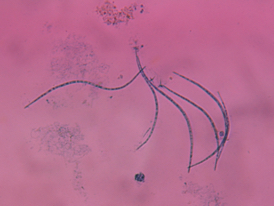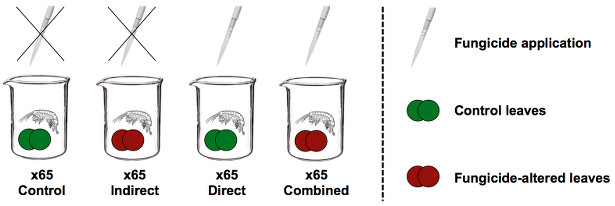In this post, we talk about our recently published paper “Waterborne toxicity and diet-related effects of fungicides in the key leaf shredder Gammarus fossarum (Crustacea; Amphipoda)”.
In a recent post, we presented a paper in which we showed that dietary exposure to the inorganic fungicide copper can – at least in certain situations – be an even more important effect path in leaf-shredding invertebrates than waterborne toxicity. In a just published paper, we assessed if a similar pattern can be observed for organic fungicides. Exposure to these substances can negatively affect leaf-associated fungal decomposers on which leaf-shredders’ nutrition heavily relies and can repel these animals from contaminated leaf material (see related post here and the associated paper here). We hypothesized that these changes in the quality of leaf material brought about by organic fungicides would adversely affect the physiological status of shredders when feeding on these leaves over the long term.
To test this hypothesis as well as the importance of this diet-related effect pathway relative to waterborne toxicity, we performed a 24-days-lasting bioassay with the crustacean shredder Gammarus fossarum using a 2×2 factorial test (see schematic graph) and a model mixture of five organic fungicides at a sum concentration of 62.5 µg/L.
The applied fungicide mixture affected gammarids’ energy processing (feeding and/or feces production) and impaired their physiological fitness (judged by the animals’ growth) via both the waterborne and diet-related effect path, which acted additively when combined. The present study thus provides further evidence that the diet-related effect pathway should be considered during the environmental risk assessment of inter alia fungicides to safeguard the integrity of detritus-based ecosystems.
The paper was authored by Jochen Zubrod, Dominic Englert, Jakob Wolfram, Simon Lüderwald, Dennis Wallace, Nadja Schnetzer, Patrick Baudy, Marco Konschak, Ralf Schulz, and Mirco Bundschuh and published in Aquatic Toxicology.
For further reading, see also the first author’s ResearchGate page: 
You may also be interested in:
EU fungicide risk assessment not sufficiently protective for key drivers in leaf litter breakdown


